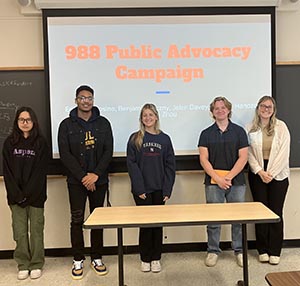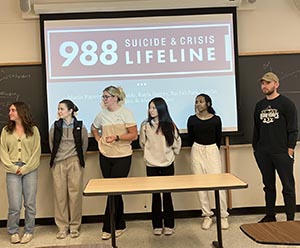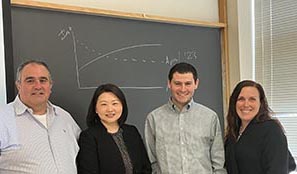
Calling or texting 988 in the U.S. instantly connects the caller to the Suicide & Crisis Lifeline, previously the National Suicide Prevention Lifeline (NSPL). Replacing the original ten-digit suicide prevention hotline number, the new, simple, three-digit 988 number was launched nationally in July 2022.
Implementing the 988 Suicide and Crisis Lifeline as an alternative to 911, to assist people who “have thoughts of suicide; need mental health-related crisis support, or are worried about someone else,” (according to the Department of Human Services’ Division of Mental Health and Addiction Services) is of critical importance in New Jersey and nationally.
The Centers for Disease Control and Prevention (CDC), has reported that suicide is a leading cause of death in the United States. In 2020 alone, 45,979 Americans died from suicide. This equals about one death every 11 minutes. The number of people who think about or attempt suicide is even higher. In 2020, an estimated 12.2 million American adults seriously thought about suicide, 3.2 million planned a suicide attempt, and 1.2 million attempted suicides. Suicide is now the second leading cause of death for people aged 10–34 years.
NAMI NJ (National Alliance on Mental Illness of New Jersey) has advocated for 988 on an ongoing basis since the National Suicide Hotline Designation Act of 2020 was passed. As part of a national coalition, NAMI National led the charge for the creation of 988 and has successfully pushed for increased federal funding in FY23 federal appropriations and the Bipartisan Safer Communities Act of 2022. Since then, NAMI NJ has worked to facilitate its successful implementation by ensuring three main components are in place: 24/7 crisis call centers, mobile crisis teams, and crisis stabilization programs.
 With the assistance of eleven students at SC&I, they now have strategic communication plans for launching two campaigns – a public awareness campaign and a policy advocacy campaign – to help them achieve their goal.
With the assistance of eleven students at SC&I, they now have strategic communication plans for launching two campaigns – a public awareness campaign and a policy advocacy campaign – to help them achieve their goal.
In March 2023, three NAMI NJ representatives, Executive Director Meredith Masin Blount; Rutgers alumnus Matthew Camarda ’20 (he holds a Master of Public Policy from the Bloustein School of Planning and Public Policy); and SC&I alumna Maggie Luo ‘MCIS’04, began collaborating with the undergraduate students in Professor of Communication Itzhak Yanovitzky’s Spring 2023 Health Messages and Campaign Design class. The students’ assignments: develop a blueprint for a theory-grounded and evidence-informed public education campaign, and a policy advocacy campaign.
Blount said, “NAMI NJ was excited to be a part of this project. The students gave us new perspectives and ideas on how to continue to communicate and advocate for this this very important program- 988. The students should be proud of themselves, as their work will impact millions across the State of NJ. Thank you!”
The 4-week project timeline officially began in March 2023 when Camarda visited the class to meet the students and explain NAMI NJ’s project goals. Following Camarda’s visit, the students went to work on the 4-week projects.
During the visit, Camarda said, “I’m grateful for the connection that NAMI NJ has built with the School of Communication and Information and excited about the opportunity to give students a way to apply the skills they’ve been learning to a critical policy issue that will save lives.”
Yanovitzky randomly divided the students into two teams. The team working to develop the public education campaign was asked to identify key target audiences; consider how health disparities, systemic oppression, and cultural differences will impact how communities’ approach and react to 988; identify partnership opportunities with local, state, and national organizations; propose ideas for outreach events; and create example of possible messages.
The team working on developing the policy advocacy campaign was tasked with identifying a target audience of legislators (legislative leadership, relevant committee chairs, bill sponsors, and supporters of mental health); craft messaging to appeal to different sets of values and political ideologies; propose partnership opportunities with local, state, and national organizations; and suggest potentially effective messaging and ideas for advocacy events.
“The students,” Yanovitzky said, “searched for relevant research to use, in conjunction with the theories and tools they acquired in the course, to plan the campaigns. This was challenging, given that little research regarding the implementation of 988 is currently available. Despite this, the students were able to locate and use a number of useful resources, including public opinion polls and news reports highlighting several early challenges to the implementation of 988 in NJ and beyond.”

A month after Camarda’s visit, the students were ready to present their two campaigns to Blount, Camarda, and Luo, who attended the class in person to watch the students present and provide them with feedback.
“The team tasked with developing the public education campaign highlighted the importance of messaging going beyond increasing awareness of 988 to set expectations regarding interactions with the service since it is new and unfamiliar relative to 911,” Yanovitzky said. “They also emphasized the potential utility of partnering with other community-based organization to disseminate information about 988 while addressing important cultural differences.
“The team tasked with developing the policy advocacy campaign proposed to further educate policymakers about the true cost of implementing 988 beyond funding the call centers, make the case for cost-saving aspects of implementing 988 in terms of medical care, public safety, and mitigating related problems such as drug overdoses, and partnering with other advocacy groups in the state and beyond to politically pressure policymakers to act on this issue.”
One of the resources students found and used was a highly relevant policy brief produced by Yanovitzky and the Project ASPEN team that surveyed NJ residents regarding ways to pay for 988, as well as another report, from a different source, that summarized how other states are paying for 988, both relevant to New Jersey policymakers as they decide how to fund 988 in the state.
Ben Buczny COM’24, who is minoring in Political Science and Music, was a co-presenter of the policy advocacy campaign. Describing his experience working on the campaign, he said “When we were charged by NAMI to create this campaign strategy, I was itching to get to work. I’m passionate about civics, public policy, and communications, so the opportunity to build a campaign for a leading provider of mental health resources was incredibly enriching. With Dr. Yanovitzky’s guidance, we analyzed demographic data, public opinion polls from the Eagleton Institute at Rutgers, and federal and state funding records to create a strategy that addresses New Jersey lawmakers and stakeholders on the issues of alternative funding for 988 programs and services. I hope this strategy can help NAMI in whatever small way it can, and I want to thank NAMI for the challenging opportunity.”
 Megan Gaido COM’23, a co-presenter of the public education campaign, said, “As a mental health advocate I was excited to work on this project specifically focused on developing a public education campaign to inform the public about the hotline's purpose. Working with NAMI members was a highlight of the experience as they provided us with valuable information and insight to help make our campaigns more effective. Collaborating with my group was an enjoyable and learning experience as we worked together to decide on the direction we wanted to take while incorporating each other's ideas to achieve the best possible outcome. I found this project to be a fantastic opportunity to apply the skills I had learned in the course to a real-world scenario. Overall, I am glad to have been able to have this experience.”
Megan Gaido COM’23, a co-presenter of the public education campaign, said, “As a mental health advocate I was excited to work on this project specifically focused on developing a public education campaign to inform the public about the hotline's purpose. Working with NAMI members was a highlight of the experience as they provided us with valuable information and insight to help make our campaigns more effective. Collaborating with my group was an enjoyable and learning experience as we worked together to decide on the direction we wanted to take while incorporating each other's ideas to achieve the best possible outcome. I found this project to be a fantastic opportunity to apply the skills I had learned in the course to a real-world scenario. Overall, I am glad to have been able to have this experience.”
Commenting on the campaigns and the various ways NAMI NJ might utilize the student’s findings, Luo said, “It is satisfying to see how SC&I students aspired to creating impact through this real-world project which exposed them to a grassroots nonprofit organization’s important work in helping people affected by mental illness get help early. Our team looks forward to incorporating their creative insights and thoughtful resources into our stigma-busting work.”
Learn more about the Communication Department at the Rutgers School of Communication and Information on the website.
Image and photos: Carol Peters
